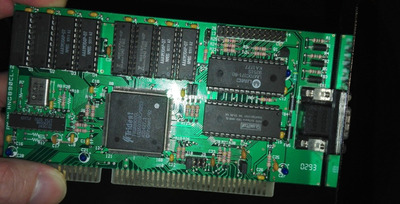@pshipkov
Thank you for the kind words. Definitely have more planned for the Batman's Revenge in the future!
Not sure about DC's licensing; it's possible, but the actual board name is "Premiere PCI."
It's mostly referred to as Batman, but not sure why. Same with other Intel codenames--Mainspike, Marryville, etc.
Not sure where they come from, if more internally-designated or externally so. Interesting nonetheless!
Batman's Revenge is really well-built. Not like lots of other Socket 4 boards that are just Socket 3 boards w/ a Pentium grafted on.
It's stable, fast enough, and pretty easy to use. Definitely not the worst, but like you said, very rigid and not ideal.
@AnonymousCoward hit the nail on the head. Not even the DX4-100 existed on market at the time.
DX2-66 is certainly no match. P66 is arguably faster/superior to the much later P75 as well. Pretty impressive stuff for the time.
Ran some 3D studio and got the following results:
- [66Mhz]: 124 seconds
- [60Mhz]: 137 seconds
Pretty solid clock-for-clock, I'd say. The Pentium FPU is truly a beast.
Integer performance is also cream of the crop.
I can re-run on an SiS50x board from later and we can do some comparisons.
Not quite 5x86-160 level, but certainly better than what I'd guess a P75 would do.
FDIV bug is an interesting one. I think @BitWrangler hit the nail on the head there. For scientific apps it was a problem.
I'd imagine most major research institutions and universities were quite displeased having to send in their CPUs for replacement.
Great information regarding the Trident boards--thank you very much for that!
Always wondered about the differences. I am curious in the 9685.
I can attest the 9880 is very good. It's not the fastest, nor the most special, but it's decent for 1999 3D graphics.
The 9440AGI/-1, 8900CL/D, and 9685 seem to make up affordable, easy to find good all-arounders for 2D graphics. Nice cards, honestly.
@maxtherabbit hit the nail on the head; zero wait and FIFO are the key to it all.
----
@BitWrangler
Well said with respect to the first gen of P5s. Definitely interesting chips and really solid performance for what they are.
I think performance w/r/t MP3s, websurfing, multitasking, solid Win95 experiences are all great examples of why the future was P5.
There's a lot of charm in this platform. It's a shame that S4 died quickly; S5 is great and all, but S4 feels like a hybrid between a 486 and 586 in way that just makes you smile.
I like your take on the 6x86 as well. A windows accelerator is a great way to put it; these things were beasts at 16-bit code and truly great for ALU-intensive tasks. Any FPU deficit as it came to gaming really would've been overcome by a Voodoo 1/V1000/etc. anyway, and true power users weren't the key market of Cyrix (from what I can tell). I do think that the PR thing was massive bs and that it was just all around deceptive, terrible business practices. It's frustrating, looking back at it. But it's also ingenious.
----
@AnonymousCoward
Agreed on all fronts. I think the P5 was an unparalleled beast; great for scientific apps and really interesting in terms of flexibility for professionals. Really interesting too in that it in many ways fit the 486 mold of things; the boards were not too different from their contemporaries and the feature set was not so functionally different that it'd confuse a new user. I think that's pretty appealing, all things considered.
I think Intel's feats were really only paralleled like you said by the Cyrix 6x86-P200+. I think the K6-233 was equally awesome but its thunder was stolen by the PII's release. It's wild to think that the Cyrix 6x86-P200+ was the first CPU to really "dent" Intel's stronghold on having the fastest chips in the early Pentium days. The unfortunate thing about the P200+ is that it feels like it never really had any good platforms that were mature enough to handle it well. 75MHz FSB was pretty hard to handle on a lot of consumer boards. Thankfully there were enough good ones out there, but it seems like having good mainstream boards capable of such took longer than the time for which the 6x86-P200+ was available. It seems like a relatively "rare" CPU these days, for whatever that's worth. They're not hard to find, per se, but it seems that not too many were made and really only those who know why they matter want them, otherwise, I see 6x86L-PR200s much more often.
320x240 at high color seems weird for the 9000i, but it makes sense given the cheapness of the card. Kinda wild, honestly. What's even the use of high color at such a resolution?
----
@andre_6
The PhilsComputerLab benchmark suite is excellent, as noted by pshipkov. It's very easy to use.
I'd recommend running options 2), 5), 6), a), b), c), and whatever else suits your interests.
Those are what we tend to use the most in this thread.
I'm curious to see your results! Please do share them, if you don't mind.
These past few posts have piqued my interest a bit in Trident hardware.
-Live Long and Prosper-
Feel free to check out my YouTube and Twitter!
